 |
The Agfa Karat 2.8 was the first of a second generation of the Karat series which involved a complete restyling of the camera body, the addition of a rangefinder and the use of faster lenses (five-elements f/2.8 Xenars, see below). What stayed initially was the Karat cassette system. The new model was called the Karat 2.8, following the tradition of naming the Karats after their fastest aperture. Only later, during production of the second version with accessory shoe, began Agfa engraved 'Karat 12' in the top plate, probably to distinguish it from the Karat 36. The latter used 135 film rolls for a maximum of 36 exposures, whereas the Karat 12 still used the Karat cassettes which allowed only 12 exposures.
There is some discussion on the internet when the Karat 2.8 was first produced, before or after WWII, due to the unusual lens serial# which fall outside the normal Schneider Xenar range (more details follow below) and the associated uncertainty when these were made. As the Karat 2.8 is shown in 1941 advertisements together with other pre-war Karats it was clearly in production by then. Shutter serial# comparable to Kodak Retinas from 1939 suggest the Karat 2.8 production probably started before onset of WWII. The Karat 12, however, was introduced well after WWII.
Agfa Karat 2.8 v.1
The Karat 2.8 was a big change from the earlier Karats. It had a larger and more angular body, was considerably heavier, and had a large metal top housing which a split-mirror rangefinder. A depth of field indicator was located where on most cameras the rewind knob would be (the Karat did not have one as rewinding was not necessary due to its cassette system) and a film indicator could be found on top of the camera. An accessory shoe was lacking, which is the main distinctive feature of the first version of the Agfa Karat 2.8 compared to the second version.
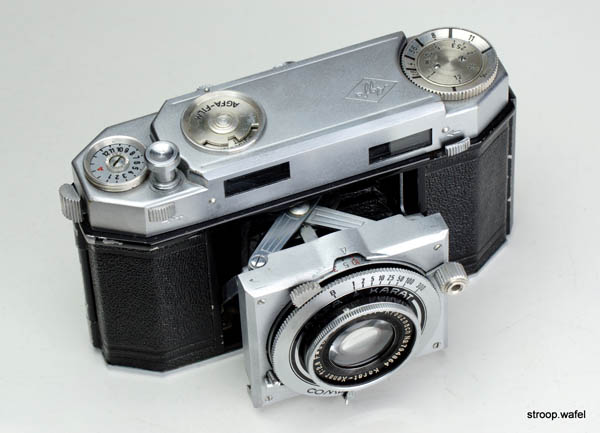
First type of the first version Agfa Karat 2.8 (v1a) with painted shutter plate, sporting a Schneider-Kreuznach Karat-Xenar 50mm f/2.8 #794864. This example has a Compur shutter like most commonly found on this model, although some had Compur-Rapid shutters.
There were three slightly different types of this first version of the Karat 2.8, which differed in shutter plate styling. The first type (Karat 2.8 v1a) had a shutter plate with all markings painted on it, similar to earlier Karat 3.5 models. The second type (Karat 2.8 v1b) also had a painted shutter plate, but it had a separate plate with aperture markings screwed onto it. The third type (Karat 2.8 v1c) had two small plates screwed onto the shutter plate, one with aperture marking and one with the name 'Agfa Karat' as well as the shutter speed indicator. There were a few more small differences, for instance the second version had a small plastic shield between the top housing and the wind knob, to avoid damage to the top housing when the wind knob sprung back after winding. This shield was missing on the first version.
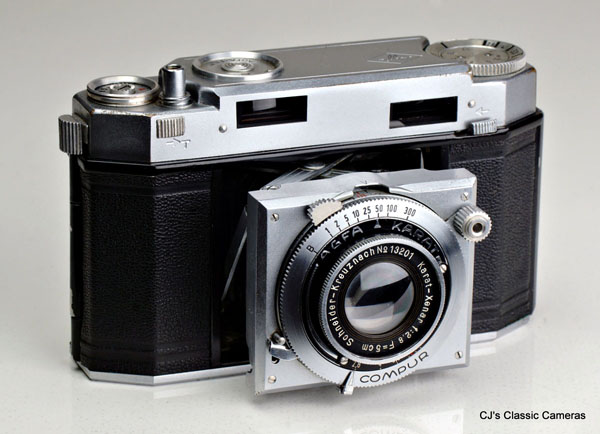
Second type of the first version of the Agfa Karat 2.8 (v1b) with screwed-on aperture markings.
A peculiar feature of the Agfa Karat 2.8/Karat 12 range is that there are three ranges of serial numbers on their Schneider-Kreuznach Xenar lenses, with numbers of around 800,000, around 20,000 and around 2,000,000, respectively. The 800.000 series was only found on the Karat 2.8 v1a (without accessory shoe and with painted shutter plate), whereas the 2 000 000 series was only found on the later Karat 12. The 20,000 range was used on the Karat 2.8 v1b and v1c, as well as the Karat 2.8 v2 (with accessory shoe), and on the early Karat 12.
According to historical information of Schneider lens serial numbers, the 800,000 series was produced around 1935, before even the first Agfa Karat was introduced. Had Agfa perhaps used a batch of old lenses at the start of Karat 2.8 production? It seems unlikely, as Xenars of that time all were f/3.5 lenses, whereas the f/2.8 lenses were Xenons. In fact, the Karat Xenars were the first f/2.8 versions Schneider seems to have made. I do have a theory about the numbering, although it is a little speculative. The first range of Karats (pre-war Karat 3.5-6.3) have different lenses (Solinar, Oppar) but a continuous range of serial#. However, there is a conspicuous gap of numbers right in the middle of a batch of Karat 4.5 v2, where numbers jump from 775,000 to 820,000. The 800,000 series of the Karat 2.8 v1a falls right in here (the observed range is 794,000-809,000). This seems hardly a coincidence, and if true, it means that Agfa ordered a large batch of Xenars for their new Karat 2.8 model in 1939. This does match the first appearance of this model. The origin of the five-digit serial numbers is even more enigmatic, but I suspect this new numbering was introduced when production resumed after WWII.
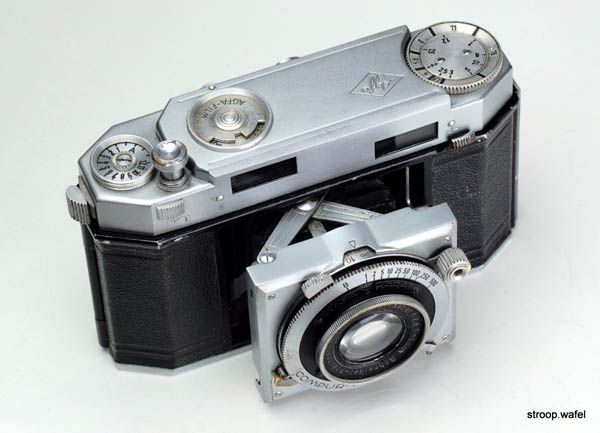
Third type of the first version of the Agfa Karat 2.8 (v1c) with screwed-on shutter plate, sporting a Schneider-Kreuznach Karat-Xenar 50mm f/2.8 #18120.
The Karat 2.8 v1b (with screwed on aperture scale) also throws up a few enigmas. Typically cameras can be dated or at least put in relatively order by their body serial#, lens serial# and shutter serial#. The Karat 2.8 generally had body serial# composed of a three-digit number between 500 and 999 preceded by a letter, the latter counting down the alphabet, not up. As mentioned above, the lens serial# are not much help, as there are three different ranges, none of them matching that of the 'regular' Xenar numbers. The shutter serial# is where the confusion starts. On the Karat 2.8 v1a the Compur shutters can be dated to around 1939. Confusingly, on the Karat 2.8 v1b the shutters predate these by about a year.
The mystery increases once one removes the aperture scale on the shutter plate, only to reveal a different scale up to f/3.5, and then it becomes apparent that these are pre-war Karat 3.5 shutter plates. So the was second type in fact the first type to be build, and are the body serial# out of sequence? I don't think so, as there is an additional serial# to be found, on the cameras' rangefinders. These confirm the sequence of the body serial# and put the Karat 2.8 v1b type after v1a. So my best guess is that the Karat 2.8 v1b were build using some leftover parts of Karat 3.5 production, most likely after rebuilding the production lines after WWII, although this is difficult to verify.

Shutter faces of the three versions of Karat 2.8 side by side. Note the screwed-on aperture scale on the middle one, which covers the painted aperture scale of a pre-war Karat 3.5.
The Karat 2.8 v1c continued the sequence of body serial# but once the letter A was reached, the number '1' was added to the three-digit number and after that a second letter was added, resulting in the serial# of two letters followed by 4 digits, which is the same system as could be found on the earlier Karat models. Very shortly after, the second version of the Karat 2.8 was introduced (below). The 5-digit lens serial# of the Karat 2.8 v1c continued on from the Karat 2.8 v1b, and continued later in Karat 2.8 v2.
Estimated production numbers are ca. 9000 for the first type, and ca. 2000 each for the second and third type.
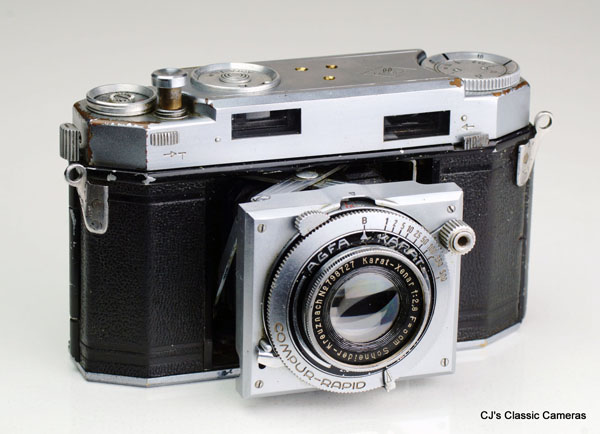
A fairly rare variant of the Karat 2.8 v1a with a Compur-Rapid shutter instead of the more common Compur shutter. It was built around the same time as the Compur version above, as camera body, lens as well as rangefinder serial # are all very close. The strap lugs are a later modification, as are the three holes in the top where an after-market accessory shoe had been fitted.
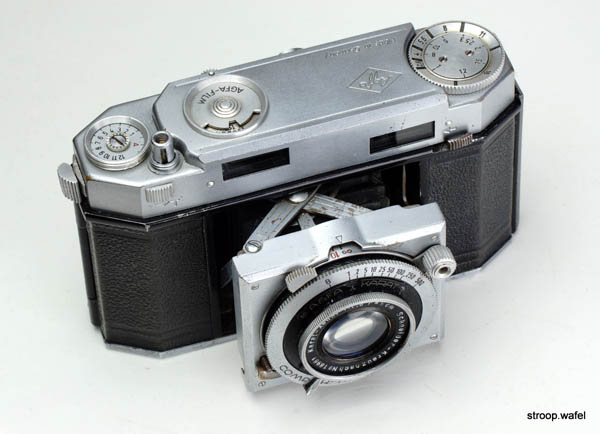
This example is a slight variant of the Karat 2.8 v1c above, the only observable difference being that this one has 'Made in Germany' engraved in the top plate. Well, the shutter release button is also different, but this version could be find with either button. On both models the focussing scale is in meters, so export to UK or USA does not appear to have been the reason behind the 'Made in Germany' markings.
Agfa Karat 2.8 v.2
The second version of the Agfa Karat 2.8 is a lot less enigmatic than the first version above. The main difference is that it obtained an accessory shoe and that the Agfa logo on the top housing was moved sideways because of this. The camera still had no markings identifying it as a Karat 12 (or 2.8 for that matter, keeping with the tradition of not putting models names on the Karats). It was otherwise identical to the Karat 2.8 v1c, with screwed-on aperture markings. This version only came with Compur-Rapid shutter and can be found with either mushroom-shaped or straight shutter release button. The Xenar lenses all have five-digit lens serial nr. ranging from about 17,000 to 24,000, which partially overlapped with the range of the Karat 2.8 v1c.
Lens markings changed during production: until about 22,000 aperture and focal length were indicated as 'f:2,8 F=5cm', after that it changed to 'f:2,8/50' and it received a red triangle mark, indicating the lens was coated (see examples below). Around # 24,300 this triangle changed to white. The Karat 2.8 v.2 were produced after WWII from ca. 1947 until about 1950 with a total production of ca. 8,000.
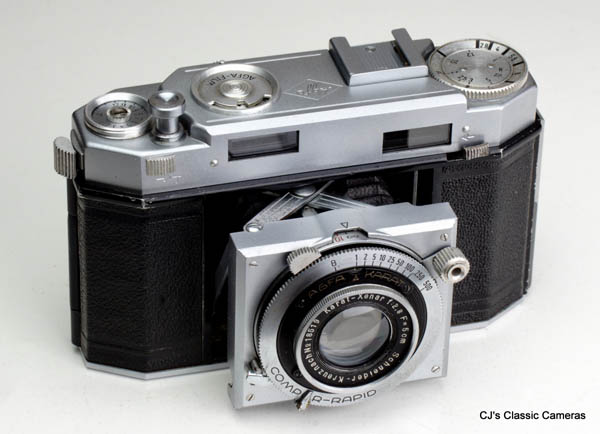
Early example of the second version of the Karat 2.8 with uncoated Schneider-Kreuznach Karat-Xenar 50mm f/2.8 #18519. Note that although the camera has an accessory shoe, it has no flash sync socket. As the only other use of the shoe I can think of would be a rangefinder, which the camera already has, I am not sure what the shoe was for.
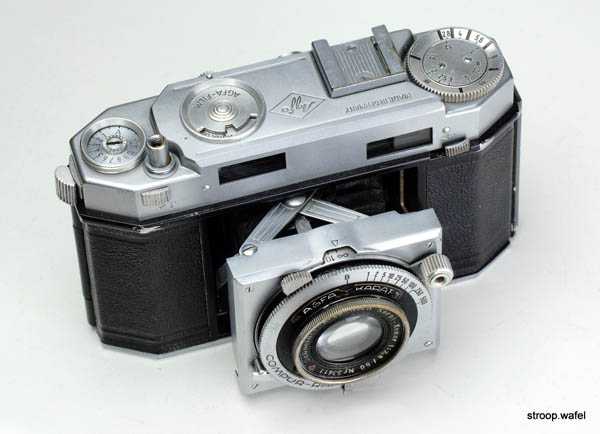
A later production example of the second version of the Karat 2.8. This example has a Schneider-Kreuznach Karat-Xenar 50mm f/2.8 #23411. Just about visible is the red triangle indicating the lens was coated (the coating is not very obvious in this picture), clear evidence of post-war production. It is otherwise nearly identical to the example, except for the 'Made in Germany' engraving in the top plate and the shape of the shutter release button.
Agfa Karat 12
The Agfa Karat 12 was nearly identical to Karat 2.8 v.2 but had 'Karat 12' engraved in the top plate. They still came with a Compur-Rapid shutter. Quite a few small variations exist, some have flat shutter cocking levers similar to the Karat 2.8, (later) others have round cocking levers. Some have flash sync sockets, which could be located either top right or top left of the shutter housing, others have no flash sync. Both straight and mushroom-shaped release buttons can be found.
Early production had five-digit lens serial # which largely overlap with that of the Karat 2.8 v2. However, most have lens serial# of around 2,000,000, which partially overlap with those of the first Karat 36. It thus appears both models were made at the same time and the Karat 12 were marked as such to distinguish them from the Karat 36.

This version has Karat 12 engraved in the top plate. It has a Schneider-Kreuznach Karat-Xenar 50mm f/2.8 #2046603, but examples with 5-digit serial# could also be found.
Agfa Karat 2.8 schematic diagram
Below is a schematic diagram of the Karat 2.8 showing all the components of the lens, shutter and focus mechanism. It was similar for later models (Karat 36 and Karat IV), except that these had a shutter cocking rod added. There's also a small arm connected to the rangefinder, which is invisbile in these images.
 Super-Xenar lenses
Super-Xenar lenses
A little known fact is that all the Karat-Xenars on the Karat 2.8 and Karat 12 were five element Xenars, also known as Super-Xenars (although this name was never actually used on the lenses themselves). Whereas the regular Xenar f/3.5, such as commonly found on Kodak Retinas, were four-elements lenses with a design comparable to the Carl Zeiss Tessar, the faster f/2.8 variant used on the Karat 2.8/12 was a modified design where the front element was split in two, resulting in a lens with five elements in four groups. Interestingly, a similar five-element lens can be found on some Kodak Retina II, but on this model it was named Retina-Xenon f/2.8, which was available in addition to the 'regular' f/2.0 Retina-Xenon. Why the same lens was named Xenon on Retinas and Xenar on Karat is unclear. Except for Xenars on early production Karat 36 v1, the Karat-Xenar f/2.8 on the Karat 36 was a regular four-element Xenar again.
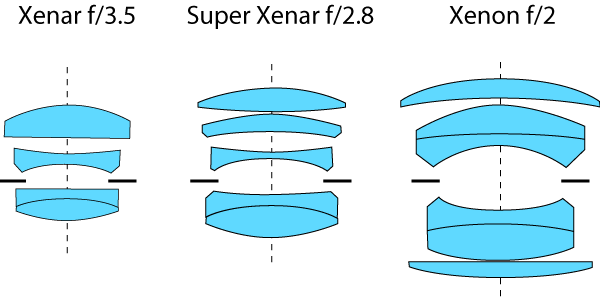
Optical design of the Schneider f/3.5 Xenar, f/2.8 Super-Xenar and f/2 Xenon lenses.
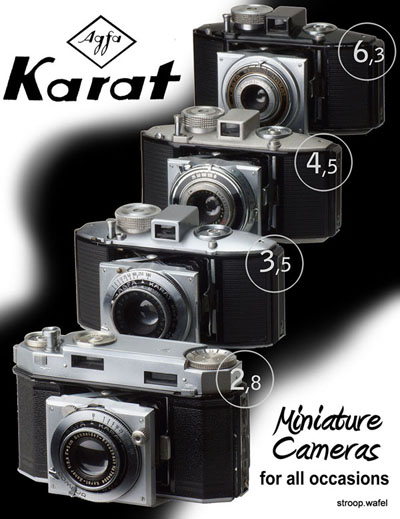
As a bonus for if you made it to the end of this page, here's an photo I made inspired by an Agfa Karat advertisement from 1941 in German. It features some of the Karats in my collection. This ad proves that the Agfa Karat 2.8 was already in production at the beginning of WWII, as it was shown with the other Karat models in production at that time (late pre-war models of Karat 3.5 and Karat 4.5). The original can be found on karat-kamaras.de (under Atiquariat - Werbung, the site does not support direct links).
|

